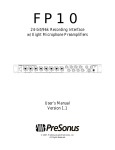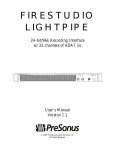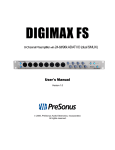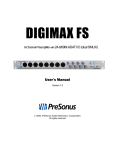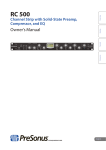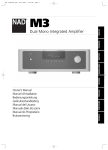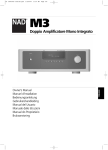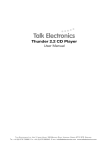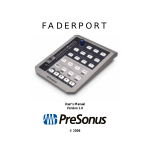Download PreSonus DigiMax D8
Transcript
DIGIMAX D8 8 Channel Preamplifier with 24-bit/48 kHz ADAT out User’s Manual Version 1.0 © 2007, PreSonus Audio Electronics, Inc. All Rights Reserved. PRESONUS LIMITED WARRANTY PreSonus Audio Electronics Inc. warrants this product to be free of defects in material and workmanship for a period of one year from the date of original retail purchase. This warranty is enforceable only by the original retail purchaser. To be protected by this warranty, the purchaser must complete and return the enclosed warranty card within 14 days of purchase. During the warranty period PreSonus shall, at its sole and absolute option, either repair or replace, free of charge, any product that proves to be defective on inspection by PreSonus or its authorized service representative. To obtain warranty service, the purchaser must first call or write PreSonus at the address and telephone number printed below to obtain a Return Authorization Number and instructions of where to return the unit for service. All inquiries must be accompanied by a description of the problem. All authorized returns must be sent to the PreSonus repair facility postage prepaid, insured and properly packaged. PreSonus reserves the right to update any unit returned for repair. PreSonus reserves the right to change or improve the design of the product at any time without prior notice. This warranty does not cover claims for damage due to abuse, neglect, alteration or attempted repair by unauthorized personnel, and is limited to failures arising during normal use that are due to defects in material or workmanship in the product. Any implied warranties, including implied warranties of merchantability and fitness for a particular purpose, are limited in duration to the length of this limited warranty. Some states do not allow limitations on how long an implied warranty lasts, so the above limitation may not apply to you. In no event will PreSonus be liable for incidental, consequential or other damages resulting from the breach of any express or implied warranty, including, among other things, damage to property, damage based on inconvenience or on loss of use of the product, and, to the extent permitted by law, damages for personal injury. Some states do not allow the exclusion of limitation of incidental or consequential damages, so the above limitation or exclusion may not apply to you. This warranty gives you specific legal rights, and you may also have other rights, which vary from state to state. This warranty only applies to products sold and used in the United States of America. For warranty information in all other countries please refer to your local distributor. PreSonus Audio Electronics, Inc. 7257 Florida Blvd. Baton Rouge, LA 70806 www.PreSonus.com © 2007, PreSonus Audio Electronics, Inc. All Rights Reserved. TABLE OF CONTENTS 1 OVERVIEW 1.1 Introduction ........................................................................................................................................... 3 1.2 Features ................................................................................................................................................ 4 1.3 What is in the Box ................................................................................................................................. 5 2 CONTROLS & CONNECTIONS 2.1 Front Panel Layout ................................................................................................................................ 6 2.2 Back Panel Layout ................................................................................................................................. 8 3 OPERATION 3.1 Microphones ........................................................................................................................................ 3.1.1 Condenser .................................................................................................................................... 3.1.2 Dynamic ...................................................................................................................................... 3.2 Digital Connections and Synchronization .............................................................................................. 3.2.1 ADAT Optical Lightpipe ............................................................................................................... 3.2.2 BNC Sync .................................................................................................................................... 3.2.3 Master/Slave and Multiple Digital Devices .................................................................................... 3.2.4 Setting up your DAW Software .................................................................................................... 3.3 Sample Hook up Diagrams ................................................................................................................... 3.3.1 Using the DigiMax D8 with ProTools ........................................................................................... 3.3.2 Using multiple DigiMax D8 with the FireStudio LightPipe ............................................................ 3.3.3 Using the DigiMax D8 to add preamps to a line level input device .................................................. 10 10 10 11 11 11 11 12 13 13 14 15 4 TECHNICAL INFORMATION 4.1 Specifications ...................................................................................................................................... 16 OVERVIEW 1.1 INTRODUCTION Thank you for purchasing the PreSonus DigiMax D8. PreSonus Audio Electronics has designed the DigiMax D8 utilizing high-grade components to ensure optimum performance that will last a lifetime. The DigiMax D8 is an eight-channel microphone preamplifier, with 24-bit 48 kHz ADAT output, eight PreSonus X-MAX microphone preamplifiers, and BNC word clock in for digital sync. Loaded with 8 direct outputs, individual channel input metering and -20 dB pads on every channel, the DigiMax D8 is the perfect hardware expansion for your FireStudio LightPipe, FireStudio 26x26, or any digital recording system with optical Lightpipe expansion capability including Digidesign’s HD and 003 systems, RME, Yamaha, Alesis, Mackie and many others. We encourage you to contact us at 225-216-7887 or at [email protected] with any questions or comments you may have regarding your PreSonus DigiMax D8. PreSonus Audio Electronics is committed to constant product improvement, and we value your suggestions highly. We believe the best way to achieve our goal of constant product improvement is by listening to the real experts, our valued customers. We appreciate the support you have shown us through the purchase of this product. We suggest you use this manual to familiarize yourself with the features, applications and correct connection procedure for your DigiMax D8 before trying to connect it to your recording system. This will hopefully alleviate any unforeseen issues that you may encounter during installation and set up. Please pay close attention when connecting your DigiMax D8 to your system. Bad cables and improper grounding are the most common causes of problems encountered in recording and live P. A. environments. We recommend checking your cables, connections and grounding if you experience any noise or sonic performance problems. Thank you, once again, for buying our product, and we hope you enjoy your DigiMax D8! 3 | PreSonus 2007 OVERVIEW 1.2 FEATURES The DigiMax D8 is high quality and affordable eight-channel preamplifier with analog to digital conversion, perfect for expanding an audio interface or digital mixer with ADAT input or upgrading the preamps on an analog console. The DigiMax D8 comes complete with eight high-quality PreSonus X-MAX microphone preamps, ADAT output, BNC word clock input, as well as input metering, direct analog output and -20 dB pads on every channel. Summary of features • • • • • • • • 8 Class A X-MAX microphone preamps 8 Balanced direct outputs -20 dB pads on every channel Instrument preamplifiers on Channels 1 & 2 24-bit / 48 kHz conversion ADAT Output BNC word clock input Front panel input metering display 4 | PreSonus 2007 OVERVIEW 1.3 WHAT IS IN THE BOX Your DigiMax D8 package contains the following: • DigiMax D8 Eight-channel microphone preamplifier • 6’ Standard IEC Power Cable • PreSonus Warranty Card 5 | PreSonus 2007 CONTROLS & CONNECTIONS 2.1 FRONT PANEL LAYOUT • Instrument Inputs (Channels 1 and 2). The ¼” TS connector on channels 1 and 2 are for use with an instrument (guitar, bass, etc.). When an instrument is plugged into the instrument input, the microphone preamp is bypassed, and the DigiMax D8 becomes an active instrument preamplifier. NOTE: Active instruments are those that have an internal preamp or a line level output. Active instruments should be plugged into a line input rather than into an instrument input. Plugging a line level source into the instrument inputs on the front of the DigiMax D8 not only risks damage to these inputs but also results in a very loud and often distorted audio signal. (In other words, don’t plug a line level source into the front panel jacks of channel 1 or 2.) • -20 dB Pad. These buttons attenuate the input signal on each channel by 20dB. The pad can be used to keep a hot signal from overdriving the microphone preamp. • Input Gain/Trim Control. These knobs provide the following gain structure: • o XLR Microphone Inputs. 54dB of variable gain (-4 dB to +50 dB) o TS Instrument/Hi-Z Inputs (Channels 1 & 2 only). 54dB of variable gain (-4dB to +50dB) LED Meters / Clip Indicator. Each channel features four LED level indicators. The green LEDs will light up when your input signal from the XLR (Mic) or ¼” (Hi-Z Channels 1&2 only) reaches -24 dBFS and -18 dBFS respectively. The yellow LED will light up when the channel’s input signal reaches -6 dBFS (+4 dBu). The red clip indicator LED will illuminate when the channel’s input signal reaches 0 dBFS. At this level, your mic preamp trim signal will exhibit signs of clipping such as distortion. It is highly recommended you do not allow your converters to clip (the red clip indicators to light up) as the sound quality will not be desirable. If you are having difficulty achieving a useable signal level without clipping, engage the -20 dB pad. 6 | PreSonus 2007 CONTROLS & CONNECTIONS • Clock. This button sets the DigiMax D8 to External digital sync or sets the Internal sample rate. o Press the Clock button once to set the clock to internal sync and your sample rate to 44.1 kHz. This will make the DigiMax D8 the Master clock of your system. It will be sending out word clock via the ADAT output. o Press the Clock button twice to set the clock to internal sync and your sample rate to 48 kHz. o Press the Clock button three times to set the clock to external sync. This will make the DigiMax D8 look for a master clock via the BNC word clock input. Your sample rate will automatically change to match that of your master clock. Please note: If you are using the DigiMax D8 to record into a DAW application like Logic, ProTools, Cubase or Sonar, you must set the sample rate inside your host application to match the sample rate you set on your master clock generator. 7 | PreSonus 2007 CONTROLS & CONNECTIONS 2.2 BACK PANEL LAYOUT • Microphone Pre-Amplifier. Your DigiMax D8 is equipped with eight custom designed PreSonus XMAX microphone preamplifiers for use with all types of microphones including Dynamics, Condensers and Ribbons as well as instruments and line level signals. The award winning PreSonus preamplifier design is a Class A input buffer followed by a dual servo gain stage. This arrangement results in ultra low noise and wide gain control allowing the DigiMax D8 user to boost desirable signal without increasing unwanted background noise. o 48 Volt Phantom Power. The FireStudio Project has 48V Phantom power available in groups of two via push button switches on the back panel. From right to left, each button activates Phantom power for channels 1&2, 3&4, 5&6 and 7&8 respectively. XLR connector wiring for Phantom Power Pin 1 = GND Pin 2 = +48V Pin 3 = +48V o • +22dBu Headroom. The DigiMax D8 microphone preamplifier has +22 dBu headroom. This feature gives you wide dynamic range and excellent transient response characteristics. Direct Analog Outputs (TRS Balanced). These are general purpose line-level direct outputs for each input channel. They are post gain and pre-converter. 8 | PreSonus 2007 CONTROLS & CONNECTIONS • BNC In. The BNC input allows the DigiMax D8 to be connected and slaved to an external word clock generator. • ADAT Output. This optical ADAT output sends eight channels of digital audio output. Word clock is also being sent through this output so you can use the DigiMax D8 as a clock master. • Power Adaptor Input. This is where you plug the provide IEC power cable into the DigiMax D8. • Power Switch. Push the top part of the switch to turn your DigiMax D8 on ( | ). Push the bottom part of the switch to turn your DigiMax D8 off ( O ). 9 | PreSonus 2007 OPERATION 3.1 MICROPHONES The DigiMax D8 works with all standard microphones including dynamic, ribbon and condenser microphones. 3.1.1 Condenser Condenser microphones tend to generate a high-quality audio signal and are one of the most popular mic choices for today’s studio recording applications. Because of their design technology, condenser microphones require a power source, which can be provided from a small battery, external power supply or from microphone inputs as phantom power. The DigiMax D8 sends phantom power over XLR inputs only. 3.1.2 Dynamic Dynamic microphones are possibly the most widely used microphone type – especially in live shows and when recording loud source signals such as guitar amplifiers and kick drums. They are usually less expensive than condenser and ribbon microphones, resistant to physical damage and typically handle high sound pressure levels (SPL) very well. Unlike condenser microphones, dynamic microphones do not require a power source. In the vast majority of cases, phantom power will have no effect on a dynamic microphone’s audio quality or sensitivity and will not damage the microphone. You should consult your microphone’s documentation to confirm. Dynamic microphones, especially ribbon microphones, tend to generate low output voltages, so they typically need more preamp gain than a condenser microphone. Ribbon Ribbon microphones are a special type of dynamic microphone and get their name from the thin metal ribbon used in their design. Ribbon microphones have very high quality sound reproduction qualities – especially higher frequencies sounds. However, they are very fragile and typically cannot handle high SPL’s. The most important thing to note about Ribbon microphones is that nearly all Ribbon Microphones do not require phantom power. PLEASE NOTE: unless a Ribbon microphone calls specifically for phantom power, sending phantom power to a ribbon microphone will severely damage it – usually beyond repair. Regardless of the microphone type you are using, we recommend reading your microphone’s user’s manual thoroughly before engaging phantom power or if any other usage questions may arise. 10 | PreSonus 2007 OPERATION 3.2 DIGITAL CONNECTIONS AND SYNCRONIZATION 3.2.1 ADAT Optical Lightpipe ADAT is an industry standard abbreviation for the ADAT Lightpipe protocol, which transfers eight tracks in a single fiber optic cable. Supported sample rates are 44.1 kHz and 48 kHz. When you are utilizing the eight DigiMax D8 preamplifiers and converting to the digital optical output, connect one ADAT optical cable from the ADAT output on the back of the DigiMax D8 to the ADAT optical input on your digital audio interface, workstation or digital mixer. To synchronize your system to the DigiMax D8’s internal clock, set your other device to receive external word clock via its ADAT optical input. You may need to consult your device’s user manual for instructions on how to do so. 3.2.2 BNC Sync and Word Clock When using multiple devices connected through digital audio formats like S/PDIF, AES/EBU, ADAT or TDIF, it is necessary to synchronize them to a single word clock generator. Word clock is used to keep a perfectly timed and constant bit rate between all synced devices to avoid data errors. A word clock generator creates digital pulses that contain no other data (i.e. audio). These pulses clock the internal oscillators of each device and are essential to avoid frequency drift. A word clock signal is bundled with the audio data in the ADAT Lightpipe protocol; however, many engineers prefer to keep word clock sync and audio separate from each other. This is where BNC word clock connections come into play and the DigiMax D8 has a BNC word clock input for just this purpose. You will find BNC cables used to deliver dedicated word clock in many quality studios and broadcast facilities worldwide. BNC cables are rugged, lock into position, and can carry clock signals much farther than the standard optical cable. A BNC word clock cable is a 75Ω, shielded coaxial cable with standard ‘twist-lock’ BNC-type connections on each end. Please note: BNC cables are made in several impedances. The DigiMax D8 requires an impedance of 75 Ωs to achieve consistent sync. To synchronize the DigiMax D8 via BNC word clock, you will need to run a BNC word clock cable from the BNC word clock output of your external device to the BNC word clock input of your DigiMax D8. From the front panel of your DigiMax D8, select external sync using the clock button. 11 | PreSonus 2007 OPERATION 3.2.3 Master/Slave and Multiple Digital Devices Whether you are using the ADAT output of the DigiMax D8 to generate word clock or you are using the BNC word clock output of another device as your word clock generator, it is necessary to denote one device as the “master” word clock device to which all other digital devices are synced or “slaved”. The DigiMax D8 should perform equally well as a master or a slave in most cases, although syncing it to a lesser quality clock source may affect performance. Not all word clock generators are created equal. The general approach is to determine which device has the best clock from which to reference and to designate that device as the word clock master. This is done with careful listening and A/B testing. Once you’ve determined which device is to be your Master clock, you will need to sync the remaining digital devices either through series or parallel distribution or some combination thereof. Of course, if your digital device chain only consists of one master and one slave, syncing the two is as simple as connecting a 75 Ω BNC word clock cable from the output of your master device to the input of the device you are slaving. When working with multiple slaved devices, the job gets a bit more complicated. Series distribution requires that your digital devices have both a BNC word clock input and a BNC word clock output. Parallel distribution uses a BNC “T-connector” attached to the BNC word clock input of each slaved device. This allows the word clock signal to be sent to that device and then sent on to another. A BNC word clock output on the slaved devices is not used or required for parallel word clock distribution. If the last device in the chain does not have a word clock terminate switch, it will require a BNC terminator plug to be attached to the other side of the “T-connector”. This helps to stabilize the word clock sync as well as to keep the word clock signal clean. Both word clock terminator plugs and BNC T-connectors can be purchased at most recording supply retailers. For a complete description of parallel word clock distribution as it relates directly to the DigiMax D8, see section 3.3.2: “Using multiple DigiMax D8s with the FireStudio LightPipe”. A third option for syncing your digital devices is to purchase a high quality dedicated word clock generator; and many engineers believe that using dedicated word clock generators, rather than utilizing series or parallel word clock distribution, enhances the performance of their digital audio devices. A dedicated word clock generator and distribution amplifier exists for one purpose and one purpose only: to be a Master clock. Word clock generators usually have one BNC word clock input and multiple BNC word clock outputs (sometimes TDIF, S/PDIF, or ADAT outputs as well to make them compatible with as many types of digital devices as possible). Without a dedicated word clock generator, it is necessary to split the word clock signal generated by the Master device by daisy chaining the slaved devices as described above. Because of this, many engineers feel that the resulting digital audio signals will be of a higher quality when a dedicated word clock generator is used; because all the digital devices are receiving the same digital pulse from the same source at exactly the same time. Whichever approach one uses, it is always advisable to use good quality BNC cables that are not excessively longer than necessary for the job at hand and, as with any audio cabling, it is always good to keep word clock cables separate from AC cable lines or other possible sources of interference. 3.2.4 Setting Up Your DAW Software If you are planning on using your DigiMax D8 as the master clock for your digital device system, you will need to refer to the instructions on external synchronization provided by the manufacturer of both your audio interface and your DAW recording application. Setting external sync usually must be done in both the audio interface’s control panel software application (if it has one) and your recording application. As a general rule of thumb, this will be necessary when you are using any device other than your audio interface as the master clock for your system. 12 | PreSonus 2007 OPERATION 3.3 SAMPLE HOOK UP DIAGRAMS 3.3.1 Using the DigiMax D8 with ProTools The DigiMax D8 is the perfect solutions to expand your ADAT compatible Digidesign interface. For example: To set up a Digi 003 with ProTools LE software: 1. Plug in an ADAT cable from the optical output of the DigiMax D8 to the optical input of the Digi 003 2. Plug in a BNC word clock cable from the Digi 003 BNC word clock output to the BNC input of the DigiMax D8 3. Push the ‘clock’ button on the DigiMax D8 three times, until the yellow “external” LED is lit. Please note: When using Digidesign interfaces that do not have word clock output, you will need to set the DigiMax D8 as the master clock of the system. Push the ‘clock’ button to the internal setting you prefer (48 kHz or 44.1 kHz). In ProTools, go to Setups>Hardware setup. Select “RCA = S/PDIF, Optical = ADAT” and set the clock to “ADAT”. Digi003, ProTools, and Digidesign are trademarks of Avid™ 13 | PreSonus 2007 OPERATION 3.3.2 Using multiple DigiMax D8 with the FireStudio LightPipe The DigiMax D8 is a great low cost solution to expand your FireStudio LightPipe for live or mobile recordings where a large number of simultaneous inputs are needed and two track output is enough for monitoring. To clock more than one DigiMax D8 to the same external sync you will need a BNC T-Connector for each DigiMax D8 you are connecting to your system. This is called parallel clock distribution and will allow word clock to be sent to and relayed from each DigiMax D8 in the chain. The last device in the chain will need to have a BNC terminator attached to the other side of the T-connection. All the devices between the master clock and the last device in the chain are un-terminated so as not to load the signal down. 14 | PreSonus 2007 OPERATION 3.3.3 Using the DigiMax D8 to Add Preamps to a Multiple Line Level Input Device The inputs of many audio interfaces and mixers are blended between microphone preamps and line level inputs. Balanced ¼” inputs are a great way to conserve space. Because of its direct analog outputs, the DigiMax D8 can also be used to add preamps to devices of this nature. It is important to note that when connecting two digital devices with an analog connection it is not necessary to use word clock sync. The FireStudio Tube offers six line level inputs in addition to its 10 microphone preamps. The DigiMax D8 is an easy way to expand the number of microphone preamps to 16. Connecting the DigiMax D8 to the FireStudio Tube is as simple as connecting 6 ¼” TRS-TRS cables: 15 | PreSonus 2007 TECHNICAL INFORMATION 4.1 SPECIFICATIONS Microphone Preamp Type ............................................................................................................................. XLR Female Balanced Frequency Response (±0.5 dB) ............................................................................................... 20 Hz to 50 kHz Frequency Response (±3.0 dB) ............................................................................................. 20 Hz to 150 kHz Input Impedance (Balanced) ................................................................................................................ 1600 Ω THD+N (unwtd, 1 kHz @ +4 dBu Output, Unity Gain) ..................................................................... < 0.003% EIN (unwtd, 55dB Gain, 150 Ω Input, 20Hz to 22 kHz) .................................................................... -126 dBu S/N Ratio (Unity Gain, unwtd, Ref. = +4 dBu, 20Hz to 22 kHz) ........................................................ > 101 dB Common Mode Rejection Ratio (1 kHz, 55 dB Gain) ........................................................................... > 55 dB Gain Control Range (± 1dB) .................................................................................................... -4 dB to 50 dB Maximum Input Level (Unity Gain, 1 kHz @ 0.5% THD+N) .............................................................. +14 dBu Signal Level LEDs Red / Clip (±0.5 dBu) .......................................................................... +10 dBu (0 dBFS) Yellow (±0.5 dBu) ............................................................................... +4 dBu (-6 dBFS) Green (±0.5 dBu) ................................................................................ -8 dBu (-18 dBFS) Green (±0.5 dBu) .............................................................................. -14 dBu (-24 dBFS) Phantom Power (±2 VDC) ................................................................................................................ +48 VDC Instrument Input (channels 1 & 2 only) Type .................................................................................................................... ¼” TRS Female Unbalanced Input Impedance .................................................................................................................................... 1 MΩ Line Outputs Type .................................................................................................................................... ¼” TRS Balanced Output Impedance .................................................................................................................................... 51 Ω Digital Audio ADC Dynamic Range (Awtd, 48 kHz Sample Rate) ............................................................................... 107 dB Bit Depth .................................................................................................................................................... 24 Reference Level for 0dBFS ................................................................................................................ +10 dBu Internal Sample Frequency Selections (kHz) ...................................................................................... 44.1, 48 External Sample Frequency Input .................................................................................................... 75 Ω BNC Power Input Connector Type ................................................................................................................................ IEC Input Voltage Range ................................................................................................................ 90 to 230 VAC Power Requirements (Continuous) ............................................................................................................ 20W As a commitment to constant improvement, PreSonus Audio Electronics, Inc. reserves the right to change any specification stated herein at any time without notification. 16 | PreSonus 2007




















